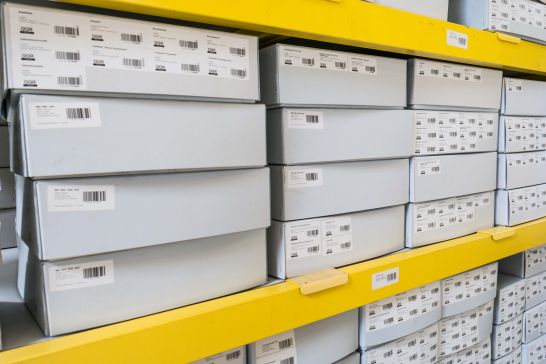Collection
From subject to museum object – how an item becomes part of the collection
(28 Oct 2015)
One of the core tasks of a museum is the care and enlargement of its collection along a specific collection concept. At the DDR Museum this happens to a large part by accepting donations from the public. Visitors can either deliver their donations directly at the entrance area of our museum or contact one of the members of the collection department. This procedure enables our staff to decide whether the specific object fits the collection concept and will represent a meaningful addition to the collection.
After a donation has found its way into the collection department, a thorough examination of its overall condition follows. The item is checked for possible defects (handling marks, insect damage for textiles, water damage, technical defects, etc.) and a decision is made concerning the measures which need to be taken for a long-term transfer into the collection. After this first examination, the item is subject to a photographic documentation. For the completion of this task, the collection department possesses the according facilities along with the necessary equipment and editing software.
The optical registration is followed by a close examination according to the content. Accordingly, a data set is created in the object database with the purpose to contain as much information about the object as possible. Along with the inventory number among these informations are descriptions of size, weight, information on the donor and condition. Additionally, the object is assigned to different topics (work, kitchen, politics, border, fashion, parenting, etc.) as well as to different collection areas (furniture, documents, photography, textiles, paintings, grocery, etc.). This classification serves a coordination of the objects according to content and is a tremendous help when it comes to retrieving the object in the database. The data set also contains the previously created photographs. From this point on, the item is referred to as a museum object.
The next step is to store the object according to archival standards. Depending on size, weight and material, different solutions are applied so our treasures will be protected as well as possible against light irradiation, variation in temperature or exposure to physical influence. After all, a collection is not founded for a couple of years but for a very long time and many future generations – accordingly, only the highest requirements are applied to the storage of a museum collection. The location within the museum depot is registered with the help of a location logging system which is connected to the museum's database. Like that, any object is easily retrievable.
However, the museum depot is by far not the “last stop on the line” for our objects. Again and again it will be necessary to take an object out of the depot. Possible ways of use are exhibition, research as well as using the object as an item on loan for other cultural institutions.
The data set to the toy stove “Brutzelette” can be found here!

